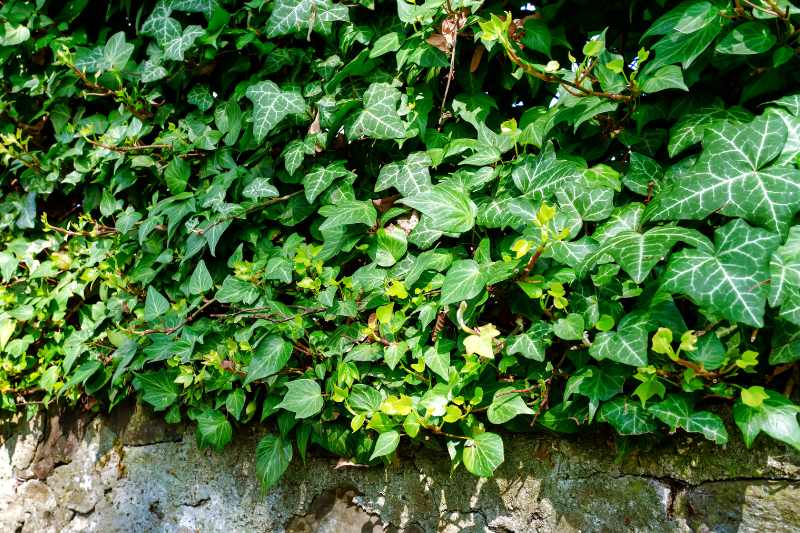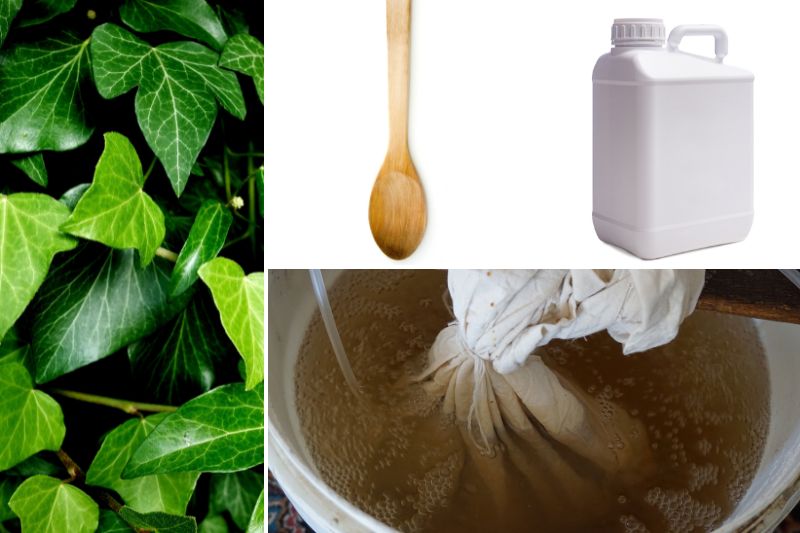Ivy manure has repellent and insecticidal properties against aphids, whiteflies (aleurodes) and mites. Ivy manure can be used preventively or curatively, but always diluted! It is a natural alternative for caring for your plants both in the vegetable garden and the ornamental garden.
Let’s discover how to prepare ivy manure and use it correctly!
Equipment needed
To make your ivy manure you will need:
- Pruning shears
- 2 buckets or other non-metal containers to avoid oxidation (one for preparation, the other for filtration)
- a clean cloth or a scrap of sheet
- a stick or an old wooden spoon
- an opaque, airtight 10-litre container
- a pair of gardening gloves
- a funnel
- kitchen scales
- a tablespoon
Which ivy to use for manure?
The common simple ivy or climbing ivy (Hedera helix) should be used to make ivy manure. Other ivy species (Hedera hibernica or Hedera colchica) and horticultural varieties (with variegated foliage, dissected foliage...) can also be used, but it would be a shame to damage them.

Hedera helix
When to make ivy manure?
Ivy is a climbing plant or creeping plant with evergreen foliage. Therefore, harvest can be carried out all year round. Bear in mind, however, that maceration of the manure is preferably done at temperatures between 15 and 25°C.
How to make ivy manure?
Ivy manure
Allow 1 kg of ivy leaves for 10 litres of rainwater. If you use tap water, leave it standing for 48 hours in the open air before use to allow chlorine to dissipate. Choose young leaves, i.e., the light green ones.
Warning: outdoor temperature must be at least 15°C but below 25°C; if it is too hot the manure may rot.
- Roughly cut the ivy leaves using pruning shear or a pair of garden scissors;
- Place your ivy leaves in the bucket of water (10 L): the bucket must not be metal; wood or plastic is fine. For ease, you can place your ivy leaves in a potato mesh bag or an old frost fleece, which will make them easier to remove before filtration;
- Cover the bucket with a cloth;
- Place in shade in a cool spot to avoid putrefaction and away from your home, as the manure can produce an unpleasant odour. Moreover, ivy contains active compounds that can be dangerous if inhaled and at very high doses. Take care and keep your manure away from children;
- Stir daily and vigorously for around ten minutes with an old kitchen utensil (wooden spoon) or a simple stick;
- Let macerate between 5 and 10 days. The result of this maceration depends on ambient temperature. Optimum is between 20 and 25°C. You will notice a white film on the surface. This is perfectly normal: it is the saponin contained in the ivy leaves rising to the surface;
- To know when maceration should stop, observe the liquid when you stir it. If bubbles remain, fermentation is not finished. If no bubbles are visible, it is ready!;
- Remove the ivy leaves and add them to the compost;
- Filter the liquid: stretch a cloth over a second container (10 L bucket), secure it with string under the bucket rim so it stays in place, and pour the manure over this cloth. You should obtain a clean liquid, free of impurities, especially if you intend to use it in a sprayer. Do not hesitate to filter a second time if you are not satisfied with the result;
- Pour your filtered manure into an opaque plastic container (light degrades the manure) using a funnel;
- Keep ivy manure in opaque plastic containers. Stored away from heat and light, in a cool place, your ivy manure can be kept for a maximum of 2 to 3 months. If the container bulges, do not worry: open it to release fermentation gases. Remember to label and date your containers!

Choose young ivy leaves. Plastic bucket, wooden spoon or stick, and finally an opaque container will be indispensable equipment for preparing your manure.
The special case of decoction
Decoction is simpler to prepare and use than manure. Proportions are the same, but leave to macerate for a single day, then bring to the boil for 20 minutes. After cooling and filtration, the decoction is ready to use. Unlike the manure, the decoction can be used undiluted.
How to use ivy manure?
Ivy manure must not be used undiluted: a 5% dilution is recommended, i.e., 5 cl in 950 ml of water.
Diluted like this, you can spray this mixture from spring until early summer, every 15 days as a preventive measure or every week in case of an insect infestation. You can add a tablespoon of black soap to your diluted manure; this will increase the preparation’s adhesion to leaves (and to insect chitin).































![[plantainfobox nom="Ivy" image="url_de_l'image"]
To make ivy {glossary} manure, you will need fresh ivy leaves, water, and a container. Here's how to proceed:
1. Collect a good amount of fresh ivy leaves.
2. Chop the leaves into small pieces.
3. Place the chopped leaves in a container and cover them with water.
4. Let the mixture ferment for a few weeks, stirring it occasionally.
5. After the fermentation process, dilute the mixture with water (1 part of ivy manure for 10 parts of water).
6. Use this diluted solution to fertilize your plants, especially those that enjoy a slightly acidic soil.
Ivy manure is a great organic fertilizer that can help improve the growth and health of your plants. [plantainfobox nom="Lierre" utilisation="Fertilisant naturel"]](https://en.promessedefleurs.eu/blogwp/wp-content/uploads/2022/11/faire-du-purin-de-lierre.jpg)
Comments